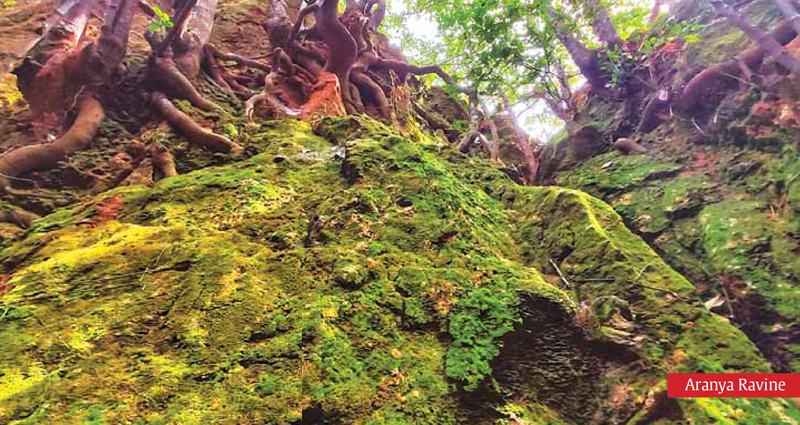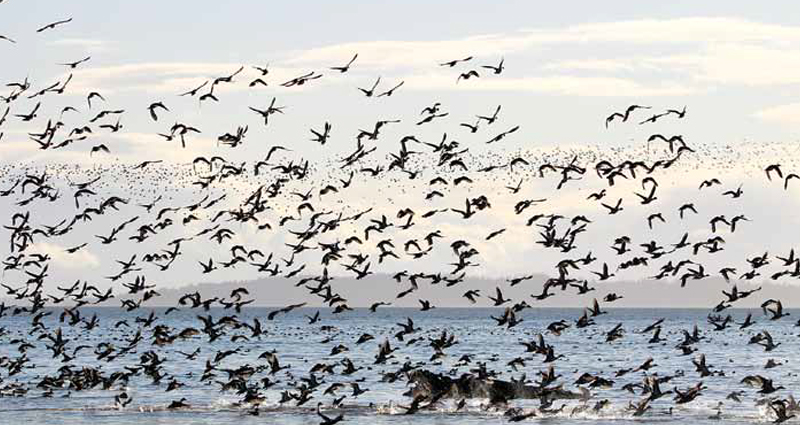
By Dr T Murugavel
When there is a will, there can be a Forest
The year was 1999, one Friday
evening I got a call from my
friend Eric Ramanujam – an
owl enthusiast, an artist and a
philatelist. I was not very surprised when
he said he is now at Aranya –a man-made
forest, in the Poothurai village, located
to the north-east of Ousteri Lake, west
of Auroville. Though I was aware of such
a green belt, I did not have an opportunity to visit. So when I got to know about
his present abode I volunteered to visit
him in the weekend. As I am bad with
directions I requested a detailed route to
reach the place, but I was told that someone will come and pick me from the bus
stand. That weekend, I started my trip.
After a 3 hours journey I got down in the
Dindivanam Junction and waited for that
someone. I didn’t have to wait long, Soon,
an unassuming person, reached the bus
stand and looked around. As I walked
towards him he gave a knowing smile and
he introduced himself as Saravanan and
requested me to sit on the pillion. That was the first time I met Saravanan – the
man responsible for Aranya.
It was my first visit to this sanctuary
and after that I have made several visits
and I have seen a barren land slowly getting transformed into a botanical garden
for indigenous plants and a heaven for
biodiversity.
It all started in 1967 when the Auroville wanted to establish an Auroville
Green Resource Centre. But nothing
much happened for almost two and half
decades. It was in 1994 when the land was
handed over to Saravanan.
The Start
It has always been a severely weather-beatend isolate waste land. The local
villagers were very sure that nothing
would grow. However, the place was
mined for pebbles. But Saravanan’s plan
was not to grow cash crops or any other
produce yielding plants. He just wanted
to plant Tropical Dry Evergreen Forest
species (TDEF) and make the place a repository of the native flora. Auroville’s
plan was also the same. Initially the
project was funded by IDRC (International Development Research Centre)
of Canada. More than36,000 native tree
saplings were planted in 100 acres. This
project of planting the saplings was spread
over three years. It was a well-thought out
plan. The local population was involved
in establishing a nursery, growing saplings, planting and nurturing them with
utmost care. The efforts did yield results
– though slowly.
When Saravanan landed there he had
to stay there in an elevated structure to
ward off venomous insects and reptiles –
which still teem the habitat.
Unlike nurturing a garden where water and manure are constantly supplied,
Saravanan watered the sapling only to
ensure that they establish themselves,
spread their roots and survive. The plants
are then allowed to grow in their natural
way. This gives the plants enough strength
to survive– fighting the elements.

He initially travelled toidentify the
last remaining pockets of sacred groves
and coastal vegetation found in the sacred
groves of Putupet, Oorani, Thangal, Alapakkam and Bahor, as well as the Kurumbaram scrub jungle near Marakkanam.
He collected seeds from these scrublands
and raised saplings.
It was a slow but steady progress.
The plants gradually established themselves and grew. However, the arid condition did have an impact on them. Over
the years, efforts were taken to increase
the water table of this eco zone and
also control erosion. Now Aranya has
a variety of tree species like Pala indigo
plant (Wrightia tinctoria) Black ebony
(Diospyros ebinum), Bayur tree
(Pterospermumacerifolium) Three-Leaf
Walsura (Walsura trifoliate), Ceylon Iron
Wood (Manilkara hexandra) and great
number of shrubs and climbers like
Paper cup flower (Plecospermum spinosum), Flame lily (Gloriosa superba). As
the flora thrived; the biodiversity of the
ecosystem increased.
Biodiversity
The variety of native flora complemented by ravines and a canyon with
a depth of 30 feet make this a place, a
unique habitat. Aranya is now a haven
for almost 240 tree species and 40 species
of herbs, shrubs and climbers. 100 plus
species of residential and migratory birds
can be sighted here, of all the birds, the
Indian Eagle Owl (Bubo bengalensis) can
be considered as the flagship species of
this habitat. Faunal diversity include Jungle cat (Felis chaus), Civet (Viverricula indica), Asian palm civet (Paradoxurus hermaphrodites), and Golden jackal (Canis
aureus) . A variety of herpeto fauna can
also be sighted here. Interestingly all the
big four (venomous) snakes live here.
During my visits to Aranya, we used to
sleep in the open on the bunds, listening
to the booming calls of the Indian horned
owls and the ping-pong ball calls of the
nightjars. During the walks you cannot
miss the porcupines’ quills strewn in the
pathways. And night walks are always
thrilling because you would not know
when you would encounter a scorpion or
a saw scaled viper. But, it is these denizens
that add value to the place, and it is the
biodiversity of this place that draw people
to Aranya.
Outreach
Aranya has also been a place for learning. Every year, more than 3,000 students,
not only from Pondicherry but also from
other states, visit the forest and get introduced to environment education and
get a hands on experience. Apart from
students, tourists, naturalists and environmentalists visit, to add adventure to
visitors, especially students, a zipline and
a rope bridge are now in place. An interpretation centre is also in the making.
Future
The tropical dry evergreen forests and
scrubland ecosystem which lined along
the coromandel coast are increasingly
becoming uncommon. What looks like a
barren land, in commoner’s terminology
a wasteland, is a distinctive ecosystem.
They are abode to certain species of flora
and fauna which make these ecosystems
biodiversity rich. Considering these, it is
evident that ecosystems like Aranya gain
much importance and need utmost care
and protection. Moreover, efforts from
the government and other non-governmental agencies are needed to create
more sanctuaries like Aranya.




